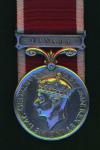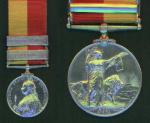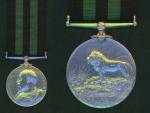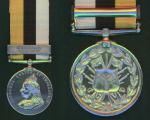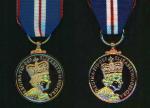
Tony Farrell
Active Contributor-
Posts
235 -
Joined
-
Last visited
-
Days Won
1
Content Type
Profiles
Forums
Blogs
Gallery
Events
Store
Everything posted by Tony Farrell
-
They are indeed named. Initial issues were struck in the standard MoD impressed capital format, though recent issues are laser-etched with the recipient's details. The medals are struck from silver, as are the bars for five year increments of service. The quality is not that bad, though please excuse fingerprints!
-
My English Ribbonbar Collection
Tony Farrell replied to Thierry's topic in Great Britain: Orders, Gallantry, Campaign Medals
The first 'representation' is Jones' group. The second is totally fictitious - and is neither imaginative nor even correct. Don't waste your hard-earned money on this rubbish. The Canadian group is pretty though, but a shame its not full sized (or is it?). -
Indian Army Ranks
Tony Farrell replied to Tony Farrell's topic in Great Britain: Orders, Gallantry, Campaign Medals
[attachmentid=22836] It's these I really want to know about. Are they appointments or ranks? You would never see a British issue medal named to an CSM or SSM. It would be WO2. Would a medal to a RDM be named as such - either pre or post-Independence? [And I want to make sure my table is correct] -
Indian Army Ranks
Tony Farrell replied to Tony Farrell's topic in Great Britain: Orders, Gallantry, Campaign Medals
So these would (mainly) be British Warrant Officers serving in Indian units? I'm assuming therefore that appointments such as Squadron Daffadar Major (a WO2 [equivalent SSM] appointment in the British Army) would be post-'48 appointments? I only ask, as the most senior Indian rank I've seen on a medal is Havildar. -
I would appreciate some clarification of the (British) Indian rank system in relation to appointments, e.g. Company Quartermaster Havildar - the equivalent of Staff Sergeant in the British Army. I'm primarily interested in pre-1948 ranks & appointments, in particular Warrant Officers. I was under the impression the the VCOs did the jobs that would've been done by WOs in British units. Basically, I want to know which Indian ranks filled the void between Havildar and the VCOs - CQHs and SQDs being appointments rather than ranks per se. Are CHMs and RQHs (WO2 equivalent) the result of rank restructuring post 1948? Did the pre-independence Indian Army have WOs?
-
Military LS&GC Medals
Tony Farrell replied to Tony Farrell's topic in Great Britain: Orders, Gallantry, Campaign Medals
I think artificial isolation is the key to preventing confusion - something I've specifically undertaken regarding the work I've been doing. The Indian LS&GC - whilst initially an Indian Army award - was extended to the naval and air arms, and was thus a truly homogeneous, joint service award. The same could not really be said of its European counterpart - the Military LS&GC, which was predominantly for the permanent military forces of the various dominions, colonies & protectorates. With the exception of the South African & Southern Rhodesian issues - which also covered the respective air arms (in leiu of the RAF LSM as per the other dominions) it was (in the main) an army LSM. This total lack of naval content sets this issue apart from the Indian medal. The award criteria also sets the Indian issue apart: (at least) twenty years' service, unit allotment, vacancy, not to mention the pecuniary issue - aspects not synonymous with its European 'brother'. The medal's design is unique also, and it is rather odd that it did not warrant its own distinctive ribbon - something that (no doubt) caused resentment amongst some. To lump the Indian issue in amongst the already 'lumped' pre & post 1930 Army LSMs is far from ideal and a distinction should be drawn to prevent confusion - which abounds with other issues that utilise similar or identical ribbon, such as the TFEMs, TEM and Efficiency Medals. One would not 'lump' IDSMs and DCMs together. Whilst they all come from 'family' groups - whether it be gallantry or long service, they all have their own distinctive traits, and only by breaking them down to workable units of isolation does one begin to understand the greater picture. -
Military LS&GC Medals
Tony Farrell replied to Tony Farrell's topic in Great Britain: Orders, Gallantry, Campaign Medals
The various issues of the Indian LSMs & MSMs ideally should have their own thread as they're a separate class of medals to the India variant of the Military LS&GC - which (as you've pointed out) were for British personnel actually serving in the Indian Army - something which causes great confusion to the uninitiated - no doubt exacerbated by ribbon commonality and the continued habit by some dealers to lump them all together. -
Military LS&GC Medals
Tony Farrell replied to Tony Farrell's topic in Great Britain: Orders, Gallantry, Campaign Medals
Military LS&GC - Canada This time a Canadian example - one of the 2200 awarded before the 'powers that be' decided to homogenise the Canadian awards system. Twelve hundred & fifty of the above total were George VI issues - which, when one considers the size of the Canadian Army at the time, is not a very large crop. Thirty-two second award bars were awarded to George VI issues and just two to the 250 retrospective Elizabeth II medals that were awarded in lieu of the Canadian Forces Decoration that replaced all Canadian LSMs. -
Military LS&GC Medals
Tony Farrell replied to Tony Farrell's topic in Great Britain: Orders, Gallantry, Campaign Medals
Military LS&GC - New Zealand I might as well post another example - this time from New Zealand. Just one hundred and nineteen George VI examples were awarded - the post-Imperial variant (1948-53) - that illustrated - being by far the rarest with just thirty nine awards. The Elizabeth II version is still awarded in New Zealand. -
I thought I?d give this an airing - my latest acquisition: Military Long Service & Good Conduct Medal ? Southern Rhodesia issue. The Military LS&GC (often referred to erroneously as the ?army? LSM) was introduced in 1930, and replaced the Army LS&GC in the United Kingdom, and (gradually) the Permanent Forces of the Empire Beyond the Seas LS&GC in the various dominions, colonies and protectorates. The British Regular Army issue not withstanding, examples to the main dominions of Australia, Canada and New Zealand (whilst not exactly plentiful) are the ones most likely to be encountered. The other relatively ?common? issue is that awarded in India ? which was neither a colony nor a dominion, but rather an autonomous British Indian administration. South African examples ? once extremely hard-to-find are now slowly starting to appear on the market. Colonial issues on the other hand are generally difficult to source, though they do crop up on the market from time to time, and several scarcities are currently listed in one notable dealer's catalogue. The Elizabeth II issue of this particular variant was only in existence for a very short time, as Southern Rhodesia (along with its northern counterpart) became absorbed in to the Central African Federation of Rhodesia & Nyasaland in 1953. It is doubtful if it was actually awarded during its brief tenure, as it was soon replaced by the Rhodesia & Nyasaland version. Whilst I have yet to confirm actual issue numbers for the Southern Rhodesia variant (1930-53) of the medal, what is certain is that it is a scarce issue, with total awards likely to be in double figures only.
-
Instituted in 1899 for operations in Uganda, the Ogaden desert and southern Sudan, it was mainly awarded to colonial troops, although British officers & NCOs on secondment received it. These are rare. Issued in both silver & bronze, four clasps were issued: LUBWA'S, UGANDA 1897-8, 1898 and UGANDA 1899. It is sometimes stated that this medal was never issued without a bar, although some specimens have been recorded. The Lubwa's clasp, however, was always issued with the clasp for Uganda 1897-8. The Lubwa's clasp was awarded for a punitive expedition against 600 Sudanese mutineers who had occupied the fort at Luba's, and a siege ensued that lasted over 2 months. The mutineers eventually broke out but were pursued and defeated at Kabarega stockade by a force commanded by Captain E G Harrison. The clasp Uganda 1897-98 was awarded for an expedition in to the Teita country led by Lt.Col. W A Broome.
- 1 reply
-
1
-
Instituted in 1901, this was the first medal to be authorised by the then new King. It was awarded to mainly West African forces, as British units were preoccupied with the war in South Africa at the time, although a few British officers & NCOs who were attached to local forces received it. This 'small war' occurred as the result of a misunderstanding by the colonial administration. The Resident Sir Fredrick Hodgson failed to understand the tribal significance of the so-called 'Golden Stool' - basically the old Ashanti throne that was in the possession of the recently instated Gold Coast government. When asked to produce the item at a meeting with the chiefs the request was denied. Insulted, this provoked a backlash from the Asantahene, or chiefs of the three Ashanti tribes and the garrison in the capital Kumassi was besieged - Hodgson included. This was the third time in 26 years that Kumassi (Coomassie) became the centre of a fight between native & colonial troops and the garrison was duly relieved on 15 July 1900 by Colonel James Willcocks and a force of around 1000 men. Willcocks then augmented his force to 3500 men with the soldiers from the garrison and brought one of the rebel tribes to battle and subsequent defeat at Obassa. Both defenders and members of the relief columns received the medal with the clasp 'Kumassi'. This 'small war' was fought under extremely harsh conditions during the wet season, against a well-armed & disciplined native army and many of the thousand or so casualties incurred perished from disease rather than the enemy's bullets. Also issued in bronze to native carriers, this particular issue is scarce. The medal in silver is not common and comes in two distinct strikings - one in a lighter definition than the other.
-
British North Borneo Medal
Tony Farrell replied to John F.'s topic in Great Britain: Orders, Gallantry, Campaign Medals
Actually Ed, I think points 2 & 3 might be the other way around. I looked in the 2005 MYB this morning (something I seldom do - much preferring the even less accurate, and much dog-eared 2001 edition) when I finished work and discovered that marked copies do in fact exist - though I've yet to examine one. DNW had a marked copy in their recent gong orgy also. I would suggest that these copies are later productions than the specimens already described - rather than the other way 'round, though I'm open to correction. I also consulted 'Taffrail' and was surprised to learn ( despite the book having been on my bookshelf since the days of monoliths & monkeys) that these medals were permitted for wear whilst in uniform. -
British North Borneo Medal
Tony Farrell replied to John F.'s topic in Great Britain: Orders, Gallantry, Campaign Medals
I think I went a bit over - more like the $150 mark. They tend to appear between ?80-100 in the UK. -
British North Borneo Medal
Tony Farrell replied to John F.'s topic in Great Britain: Orders, Gallantry, Campaign Medals
If you want to flog that to me for forty bucks ol' fruit then job's a good un. More like $180-200. -
Minted by Spink & Son of St. James's, London in 1899 for issue by the Royal Niger Company to its forces that were employed in a number of punitive actions against tribes in Nigeria. It was awarded in silver to Officers & NCOs and in bronze to natives. The clasp NIGERIA 1886-97 was authorised for the silver medal, whereas the bronze issues simply had NIGERIA on the clasp. Fewer than 100 silver medals were issued and they are exceptionally rare and command a very high price. The illustrated example is a specimen struck from the original die and is identical in all respects to the original medals - apart from the letter S in the word Son (under the Queen's head) - which is absent on the later re-strikes.
-
British North Borneo Medal
Tony Farrell replied to John F.'s topic in Great Britain: Orders, Gallantry, Campaign Medals
What you have is - to all intents - exactly the same as the original issue medal. Specimens are struck by various mints for a number of reasons. The usage of the word copy is comparatively recent, and denotes just that - a reproduction (outright fakes tend not to be marked as fake). This is not the same as a specimen, which is an actual example of an issue. I understand that the B.N.B.Co.'s restrikes were manufactured by Spinks (the original makers of the medal), using the same dies, at around the same time as those for the Royal Niger Company. This occured sometime in the 1950s if I remember [don't have books to hand] correctly. Unlike officially-sanctioned specimen strikings by the Royal Mint (and its Commonwealth counterparts) which were/are struck as proof examples for governmental departments, institutes & museums, these privately-minted specimens are more prolific in number due to their desirability - original examples being struck in very small numbers and (of consequence) being very hard to find and expensive. Specimens are the affordable solution. Unmarked 'specimens' were also struck for the purposes of officially replacing lost medals and for late applications. These are basically 'unnamed' blanks - many of which have found their way on to the collectors' market - and I have several - both marked specimen and blank. With one notable exception, they are identical to the medals awarded named to recipients. As for your medal? These were (predominantly) struck for the collectors' market. Some view such items with disdain: merely unattributable scrap specifically made for the magpies amongst us. These are not the same as the recently-manufactured (and poor) 'antiquated' (or not) copies that seemingly flood internet auction sites. I have examined several such B.N.B.Co. Spink-manufactured specimens, and they have all been marked as such and not Copy. Like most things medallic (phaleristic), specimens are contentious. I know one of the great collector/authors who has several superb specimens in his collection, which are rarities in their own right. If you are an example collector, then what you have shouldn't cause you any headaches. I'd certainly be happy with it, as a named original issue would cost several hundred pounds. -
British North Borneo Medal
Tony Farrell replied to John F.'s topic in Great Britain: Orders, Gallantry, Campaign Medals
As far as I am aware, the same rule applies to the B.N.B.Co.'s issues as applies to the Spinks-manufactured medals for the Royal Niger Company. The 'S' is removed as per the R.N.Co. specimens, and they are marked as such, i.e. Specimen, and not Copy. Yours looks like a contemporary Spink-manufactured item - struck from the original dies, and not one of the modern marked copies that can easily be sourced on eBay. -
Golden Jubilee Medal
Tony Farrell replied to bigjarofwasps's topic in Great Britain: Orders, Gallantry, Campaign Medals
You mean like Special Constabulary LSMs, 14/15 Stars, BWMs, 39-45 Stars et al? Just clock eBay for your answer. Generally, because that clown in Birmingham (who manufactures the majority of this tat)... can! -
Golden Jubilee Medal
Tony Farrell replied to bigjarofwasps's topic in Great Britain: Orders, Gallantry, Campaign Medals
Apologies for the pixellation on the above image but you get the general idea. The 'dudley' is on the left. Here's the reverse shots. Again, the dudley is on the port side. -
Golden Jubilee Medal
Tony Farrell replied to bigjarofwasps's topic in Great Britain: Orders, Gallantry, Campaign Medals
I think it was Chris Boonthingy that described the obverse effigy of the copies as looking more like a clean-shaven Ernest Borgnine than our beloved sovereign. Anyhow. The copies have a slightly thicker rim than the originals, and (as Chris points out), Betty looks like she's been at the cakes on the copies. The general relief work is much crisper on the originals. Look out for the 'bitty' effect on the copies - like they were plated in a dusty environment. -
Because he's already got a 1901 clasp on his QSA. SA01 & 02 clasped QSAs are not accompanied by a KSA. To be eligible for the 1902 clasp for the QSA, one had to have served at the 'front' between the 1st January & 31st May 1902. Five months. To be eligible for the KSA, one had to have served for eighteen months before the 1st June, 1902. Basically the 1902 bar for the QSA was for those who were 'short timers' and the KSA for the blokes who'd been in theatre for at over a year & half.



